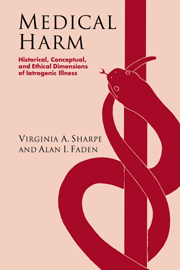Book contents
- Frontmatter
- Contents
- Acknowledgments
- Introduction
- Part I
- Part II
- Part III
- 7 From hospitalism to nosocomial infection control
- 8 Adverse effects of drug treatment
- 9 Unnecessary surgery
- 10 The concept of appropriateness in patient care
- 11 Recommendations for limiting iatrogenic harm
- Appendix
- Bibliography
- Index
7 - From hospitalism to nosocomial infection control
Published online by Cambridge University Press: 22 September 2009
- Frontmatter
- Contents
- Acknowledgments
- Introduction
- Part I
- Part II
- Part III
- 7 From hospitalism to nosocomial infection control
- 8 Adverse effects of drug treatment
- 9 Unnecessary surgery
- 10 The concept of appropriateness in patient care
- 11 Recommendations for limiting iatrogenic harm
- Appendix
- Bibliography
- Index
Summary
Historic debates: puerperal fever, antisepsis, and the germ theory of disease
What is now known as nosocomial or hospital-based infection made its indelible mark on history during the childbed fever epidemics of the eighteenth and nineteenth centuries. During this period, puerperal deaths in hospitals and lying-in institutions were estimated to be as high as 150 per 1000 deliveries, whereas the same disease afflicted less than 20 in 1000 women delivering at home. One of the first indications of the physician's role in the etiology of childbed fever was given by Alexander Gordon in 1795 in his account of 28 cases of the disease at the Aberdeen dispensary, Scotland. In this account, he expressed his conviction, based on empirical evidence from his own practice, that he and certain midwives had been the source of transmission.
The most significant epidemiological work on the physician's role in the transmission of puerperal fever was done in the mid-nineteenth century by Ignaz Semmelweis at the Allgemeines Krankenhaus in Vienna. During this period, pathological anatomy was becoming an integral part of the medical curriculum, and medical students and physicians moved freely between the autopsy and delivery rooms. Based on astute clinical observation of the two obstetric wards at the hospital, Semmelweis identified physicians going from cadavers to parturient women as the main vector of the disease. In Ward 1, where deliveries were performed by physicians and students, 600 to 800 women or 20% died each year from childbed fever.
- Type
- Chapter
- Information
- Medical HarmHistorical, Conceptual and Ethical Dimensions of Iatrogenic Illness, pp. 153 - 174Publisher: Cambridge University PressPrint publication year: 1998



